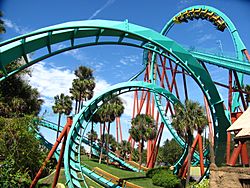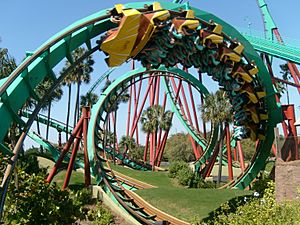Kumba (roller coaster) facts for kids
Quick facts for kids Kumba |
|
|---|---|

Kumba was the first Bolliger and Mabillard coaster to feature interlocking corkscrews, and is one of only four in the world to feature a vertical loop around the lift hill.
|
|
| Busch Gardens Tampa Bay | |
| Location | Busch Gardens Tampa Bay |
| Park section | Congo |
| Coordinates | 28°02′23″N 82°25′23″W / 28.03972°N 82.42306°W |
| Status | Operating |
| Opening date | April 20, 1993 |
| General statistics | |
| Type | Steel |
| Manufacturer | Bolliger & Mabillard |
| Designer | Werner Stengel |
| Model | Sitting Coaster |
| Lift/launch system | Chain lift hill |
| Height | 143 ft (44 m) |
| Drop | 135 ft (41 m) |
| Length | 3,978 ft (1,212 m) |
| Speed | 60 mph (97 km/h) |
| Inversions | 7 |
| Duration | 2:54 |
| Capacity | 1,700 riders per hour |
| G-force | 3.8 |
| Height restriction | 54 in (137 cm) |
| Trains | 4(3 max. in use) trains with 8 cars. Riders are arranged 4 across in a single row for a total of 32 riders per train. |
|
|
|
| Kumba at RCDB | |
Kumba is an exciting steel roller coaster located at Busch Gardens Tampa Bay in Tampa, Florida. It was built by a company called Bolliger & Mabillard and first opened in 1993. This thrilling ride stands 143 feet tall and can reach speeds of 60 miles per hour. Kumba also features seven inversions, which means you go upside down seven times during the nearly 3-minute ride!
Contents
History of Kumba
Kumba was first announced in November 1992. It was designed to be a record-breaking roller coaster for Busch Gardens Tampa Bay. The ride officially opened to the public on April 20, 1993.
When Kumba first opened, it had the world's tallest vertical loop. It was also the tallest, fastest, and longest roller coaster in Florida. Over time, other roller coasters broke Kumba's records. For example, in 1995, Dragon Khan in Spain took the record for the tallest vertical loop. Later, other rides in Florida became taller, longer, and faster than Kumba.
What Makes Kumba Special?
Kumba is 3,978 feet long and stands 143 feet tall. It reaches a top speed of 60 miles per hour. The ride features seven inversions, which are parts of the track that turn you upside down. These include a 114-foot-tall vertical loop, a dive loop, a zero-g roll, a cobra roll, and two interlocking corkscrews.
One unique feature of Kumba is its vertical loop. It wraps around the ride's lift hill. Kumba was also one of the first roller coasters in the world to have interlocking corkscrews and a dive loop. Riders on Kumba feel up to 3.8 times the force of gravity during the 3-minute ride.
Kumba's Trains and Capacity
Kumba uses four trains, each made of steel and fiberglass. Each train has eight cars, and each car seats four riders in a single row. This means 32 riders can be on one train at a time.
The ride is designed so that three trains can be on the track at once. This allows the park to keep the ride running smoothly even if one train needs maintenance. Kumba can carry about 1,700 riders every hour.
The Name Kumba
The name "Kumba" comes from the African Kongo Language. It means "Roar." This name fits the ride perfectly because of the loud roaring sound the trains make as they speed along the track. The track doesn't have sand inside to quiet the noise, which is why it's so loud!
Your Ride on Kumba
Your adventure on Kumba begins with a right turn out of the station. This leads you to the 143-foot-tall chain lift hill. Once you reach the top, the train goes through a small pre-drop. Then, you plunge down a 135-foot drop to the left.
Next, you go through a huge 114-foot-tall vertical loop that wraps around the lift hill. After the loop, the ride goes up into a diving loop, followed by a zero-g roll. In the zero-g roll, you feel a moment of weightlessness, like you're floating!
A straight section of track and a small hill lead you into a Cobra roll. After exiting the cobra roll, the trains slow down slightly on the mid-course brake run. From there, you dive into a pair of interlocking corkscrews. The train then goes into a tunnel and comes out into an upward helix that turns clockwise. Finally, the train reaches the last brake run before turning right and returning to the station.



